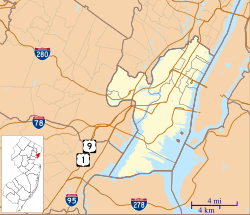Liberty Science Center
 Hoberman sphere at Liberty Science Center | |
| Established | 1993 |
|---|---|
| Location | Liberty State Park, Jersey City, New Jersey, U.S. |
| Type | Science museum |
| President | Paul Hoffman |
| Public transit access | Liberty State Park |
| Website | Liberty Science Center |

Liberty Science Center is an interactive science museum and learning center located in Liberty State Park in Jersey City in Hudson County, New Jersey, United States.
The center, which first opened in 1993 as New Jersey's first major state science museum, has science exhibits, the largest IMAX Dome theater in the United States, numerous educational resources, and the original Hoberman sphere, a silver, computer-driven engineering artwork designed by Chuck Hoberman.
History
Liberty Science Center completed a 22-month, $109 million expansion and renewal project on July 19, 2007.[1] The expansion added 100,000 square feet (9,300 m2) to the facility, bringing it to nearly 300,000 square feet (28,000 m2).[2] However, the amount of exhibit space slightly decreased with the expansion as all the new space added is open space such as queue lines for the ticketing office. Liberty Science Center also has state-of-the-art surround sound as well as a technologically advanced picture screen in the IMAX dome.
The museum's expansion has received criticism for a perceived politicization of science, for example, by Edward Rothstein of The New York Times.[3]
Exhibits

Liberty Science Center's permanent exhibitions include:[1]
- Skyscraper! Achievement and Impact - The largest exhibition on the subject of skyscrapers in the world - with artifacts from the World Trade Center, a walk along an I-Beam two stories above the exhibition floor, an earthquake-shake table, a glass-Schindler 400A mid-rise Traction elevator, which is open to show how the elevator moves, the machine room, and the pit, and much more.
- Eat and Be Eaten - This exhibit of life animals explores the predator-prey relationship, offering lots of live animals including deadly vipers, amazing puffer fish, and scores of other creatures.
- Communication explores human communication in four areas—body and language; symbols, signs, and writing; print, audio, and video; and signals and networks. Here you can also do Language Karaoke, where you are taught to say phrases in a new language: Mandarin Chinese, Arabic, Spanish, or Cockney.
- Infection Connection - Helps guests understand how individual actions may affect global health issues. You may ride the IC Express, which shows a film about different types of infectious diseases.
- I Explore - An age-restricted area, where guests under age six and their caregivers can explore aspects of the world around them through water play, a microscope, a large climbing structure, a street scape, and a rock xylophone - made from hanging rocks that ring like bells when struck.
- Our Hudson Home - Teaches guests about the wildlife and ecology of the Hudson River.
- Wonder Why - Holds many of the original exhibits from the earliest days of the museum
- Energy Quest - Explores different energy types and the technologies to harness these.
- Wildlife Challenge - A seasonal outdoor exhibit in which guests can take part in a variety of physical activities, designed to simulate different animals' environments. Activities include balance beams, and a zip line accessible only to guests that can hold on to a rope for at least ten seconds.
- Travelling exhibitions - Various temporary exhibits
- The first exhibit since the center re-opened was Islamic Science Re-Discovered.
- Goose Bumps! The Science of Fear, let guests see how they would react when they were exposed to creepy animals, loud noises, electric shock and the fear of falling. The exhibit explored why their bodies react the way they do.
- "Mammoths and Mastodons: Titans of the Ice Age" used video installations, hands-on interactive displays, life-sized models and fossils to teach more about the extinct mammals. The exhibit showcased Lyuba, the world's best preserved woolly mammoth specimen.[4]
- Titanic: The Artifact Exhibition featured over 100 authentic artifacts from the Titanic, which were set within replicas of cabins and other areas of the ship. The exhibit also allowed visitors to touch an "iceberg" to simulate how cold the water was when the ship sank.
Rubik's Cube Exhibition
Beyond Rubik's Cube opened to the public on April 26, 2014. The exhibition celebrates the Cube's 40th anniversary, and features artifacts and exhibits that trace the history of the Cube and mark the massive cultural influence it continues to have on popular culture today.[5]

Jennifer A. Chalsty Center for Science Learning and Teaching
In July 2007, the new Jennifer A. Chalsty Center for Science Learning and Teaching opened. It is a 20,000-square-foot (1,900 m2) facility extending over the entire former Invention Floor of Liberty Science Center, with six laboratories, a 150-seat theater, and other resources for teachers and students. Here educators can upgrade science teaching skills and find peers to help strengthen science instruction in the classroom, while students can participate in intense, multi-day or single hour programs to ignite interest and skills in science exploration.[6]
References
- ^ a b Kitta MacPherson. "Innovation & Inspiration" Newark Star-Ledger, Oct 4, 2006.
- ^ Liberty Science Center Expansion Project, accessed January 30, 2007
- ^ Rothstein, Edward (2007-07-20). "Touch Me Feel Me Science". The New York Times. Retrieved 2010-08-14.
- ^ Smith, Olivia (2009-04-21). "Baby mammoth Lyuba, pristinely preserved, offers scientists rare look into mysteries of Ice Age". Daily News. New York.
- ^ "Beyond Rubik's Cube". Liberty Science Center. Retrieved 16 May 2014.
- ^ Osowski, Jeffrey. "Enliven the art of teaching science", New Jersey Education Association Review, February 2006.
External links
- Official website

- Rothstein, Edward (July 20, 2007). "Museum Review: Touch Me Feel Me Science". NY Times.

